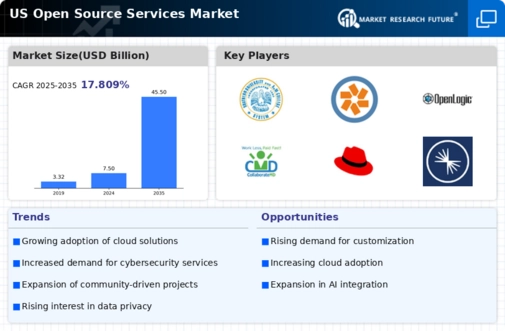The open source-services market is characterized by a dynamic competitive landscape, driven by innovation, strategic partnerships, and a growing demand for flexible, cost-effective solutions. Major players such as Red Hat (US), MongoDB (US), and HashiCorp (US) are at the forefront, each adopting distinct strategies to enhance their market positioning. Red Hat (US) focuses on expanding its hybrid cloud offerings, leveraging its strong reputation in enterprise solutions. MongoDB (US) emphasizes its database-as-a-service model, catering to the increasing need for scalable data management solutions. HashiCorp (US) is concentrating on infrastructure automation, which aligns with the broader trend of digital transformation across industries. Collectively, these strategies contribute to a competitive environment that is increasingly centered on technological advancement and customer-centric solutions.
Key business tactics within this market include localized service offerings and supply chain optimization, which are essential for meeting diverse customer needs. The competitive structure appears moderately fragmented, with several key players exerting influence while also facing competition from emerging startups. This fragmentation allows for a variety of service offerings, fostering innovation and responsiveness to market demands.
In October 2025, Red Hat (US) announced a strategic partnership with a leading cloud provider to enhance its hybrid cloud capabilities. This collaboration is likely to bolster Red Hat's position in the market by providing customers with integrated solutions that streamline cloud adoption. The partnership underscores the importance of alliances in navigating the complexities of cloud technology and meeting customer expectations for seamless integration.
In September 2025, MongoDB (US) launched a new version of its database platform, incorporating advanced AI features aimed at improving data analytics capabilities. This move is significant as it positions MongoDB to capitalize on the growing trend of AI integration within data management, potentially attracting a broader customer base seeking innovative solutions. The introduction of AI functionalities may also enhance user experience and operational efficiency, further solidifying MongoDB's competitive edge.
In August 2025, HashiCorp (US) expanded its product suite with the introduction of a new tool designed for multi-cloud management. This strategic action reflects the increasing demand for solutions that facilitate seamless operations across various cloud environments. By addressing this need, HashiCorp is likely to enhance its appeal to enterprises looking for comprehensive management tools, thereby strengthening its market presence.
As of November 2025, current trends in the open source-services market include a pronounced focus on digitalization, sustainability, and the integration of AI technologies. Strategic alliances are increasingly shaping the competitive landscape, enabling companies to leverage complementary strengths and enhance their service offerings. Looking ahead, competitive differentiation is expected to evolve, with a shift from price-based competition to a greater emphasis on innovation, technological advancement, and supply chain reliability. This transition may redefine how companies position themselves in the market, ultimately fostering a more resilient and adaptive open source-services ecosystem.
























Leave a Comment